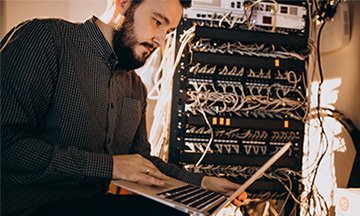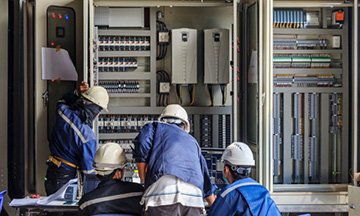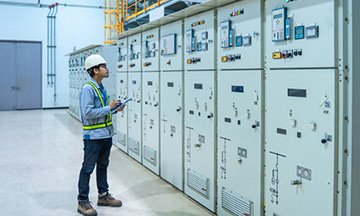Siemens SIMATIC S7-300/-400 PLC Automation Training Course
| Date | Format | Duration | Fees | |
|---|---|---|---|---|
| 29 Apr - 03 May, 2024 | Live Online | 5 Days | $2250 | Register |
| 10 Jun - 14 Jun, 2024 | Live Online | 5 Days | $2250 | Register |
| 15 Jul - 23 Jul, 2024 | Live Online | 7 Days | $3147 | Register |
| 08 Sep - 12 Sep, 2024 | Live Online | 5 Days | $2250 | Register |
| 18 Nov - 22 Nov, 2024 | Live Online | 5 Days | $2250 | Register |
| 02 Dec - 06 Dec, 2024 | Live Online | 5 Days | $2250 | Register |
| Date | Venue | Duration | Fees | |
|---|---|---|---|---|
| 22 Apr - 26 Apr, 2024 | Dubai | 5 Days | $4750 | Register |
| 20 May - 24 May, 2024 | Kampala | 5 Days | $4950 | Register |
| 20 May - 24 May, 2024 | Dubai | 5 Days | $4750 | Register |
| 24 Jun - 28 Jun, 2024 | Dubai | 5 Days | $4750 | Register |
| 01 Jul - 12 Jul, 2024 | Berlin | 10 Days | $9850 | Register |
| 29 Jul - 02 Aug, 2024 | Dubai | 5 Days | $4750 | Register |
| 05 Aug - 09 Aug, 2024 | Dubai | 5 Days | $4750 | Register |
| 02 Sep - 06 Sep, 2024 | Dubai | 5 Days | $4750 | Register |
| 22 Sep - 26 Sep, 2024 | Doha | 5 Days | $4950 | Register |
| 28 Oct - 01 Nov, 2024 | Dubai | 5 Days | $4750 | Register |
| 04 Nov - 08 Nov, 2024 | Athens | 5 Days | $5695 | Register |
| 11 Nov - 15 Nov, 2024 | Dubai | 5 Days | $4750 | Register |
| 16 Dec - 20 Dec, 2024 | Kampala | 5 Days | $4950 | Register |
| 23 Dec - 27 Dec, 2024 | Dubai | 5 Days | $4750 | Register |
Course Overview
How to load programs on S7 300/400 PLC? This hands-on, extremely engaging training course builds on the basic programming skills using Siemens STEP7 software. Participants will get to practise and learn S7 project management, program design & application development. This is an aggressively regulated curriculum covering S7 programming with Ladder logic.
The basics and fundamentals of programming with Function Block Diagram (FBD) and Statement List (STL) languages are also covered. Key software tools and best practices techniques taught.
What is covered in Simatic S7 Course? Participants employ and use the Totally Integrated Automation concept by integrating an S7300-400 PLC and ET200S remote I/O station. Throughout the duration of this course, the participants will build and run a STEP7 project from beginning to end, learning proper program structure and documenting.
Software diagnostic tools are encouraged to be used for troubleshooting both hardware and code. Various instruction sets, memory areas, program blocks, and libraries are introduced to provide the participant with solid concepts of structured programming. This course uses the current adult learning techniques featuring brief presentations followed by multiple engaging hands-on, task-based skills.
Course Facilitators verify participant skills and sign off on a task completion list throughout the course. At the end of the course, participants complete project to show case and reinforce the skills they have learned during the course.
This Zoe training course will empower you with the consciousness of knowing the extended programming possibilities of S7300-400 PLC and ET200S with the possibility for participants to build and manage a STEP7 project from beginning to end.
Course Objectives
Upon completing this SIMATIC S7300-400 PLC Automation course successfully, participants will be able to:
- Configure parametrize, communicate, direct and commission a Totally Integrated Automation System
- Program, document, check, test and troubleshoot a structured STEP7 program
- Program using absolute and symbolic addressing
- Use core and essential application instructions to program Organization Blocks (OBs), Function Blocks (FBs), Function Calls (FCs) and library blocks
- Program using binary, digital and analog processing
- Create and use data blocks
- Create and call reusable blocks by engaging and employing parameter-passing techniques
- Cross-reference where and how addresses are used, program call structure, and comparing online to offline programs
Training Methodology
This collaborative SIMATIC S7300-400 PLC Automation training program will comprise the following training methods:
- Lectures
- Seminars and Presentations
- Group Discussions
- Assignments
- Case Studies and Functional Exercises
ZTS follows the ‘Do-Review-Learn-Apply’ model.
Organisational Benefits
Companies who nominate their employees to participate in this SIMATIC S7300-400 PLC Automation course can benefit in the following ways:
- Keep your company one step ahead with this all-inclusive overview of SIMATIC S7300-400 PLC Automation
- Assist technical committees to create, publish and revise working standards relating to SIMATIC S7300-400 PLC Automation
- Carefully study and analyse examples and case studies to illustrate the material being discussed and ensure that the material is appropriate to the organisation represented
- Leave with the knowledge and understanding of their roles and responsibilities in the workplace in relation to SIMATIC S7300-400 PLC Automation
Personal Benefits
Individuals who participate in this SIMATIC S7300-400 PLC Automation course can gain from it in the following ways:
- Keep up with late-breaking developments in SIMATIC S7300-400 PLC Automation by studying new literature and other sources of information
- Benefit from a tailor-made academic program for technicians or equivalent workforce involved in SIMATIC S7300-400 PLC Automation
- Get yourself trained, assessed, and certified by experts in the SIMATIC S7300-400 PLC Automation. Know examples of issues that they encounter during their normal working activities and possible solutions
Who Should Attend?
SIMATIC S7300-400 PLC Automation training course would be suitable for:
- Programmers
- Commissioning engineers
- Configuring engineers
- Instrumentation and control engineers
- Maintenance engineers
- Electrical engineers
- Industry electronics technician
- Energy electronics technician
- Mechatronic technician
- Industrial mechatronic technician
- Personnel programming and managing other vendor’s PLC’s and who are looking to migrate their skills onto the S7 CPU
- Service staff, with a firm and steady foundation of existing PLC skills and practical experience, whose role requires them to carry out programming related tasks
Prerequisites
The ability to use and work on MS Windows PC (2000/XP), keyboard and mouse to enter opening and closing programs, locating files, copy and paste objects /data (text, etc.). Drag and drop files, objects/data (text, etc.). Know the use of menus and multi-menus, manipulation of windows in a multi-window environment. Use of MS Windows Help.
A prior knowledge and practical experience of PLC’s is essential.
Course Outline
MODULE 1: Using SIMATIC Manager
- Creating, deleting, saving, archiving, and retrieving an S7 Project
- Managing an S7 Project
- Configuring and Setting the PG/PC Interface: MPI, PROFIBUS, AUTO, Ethernet
- Online Connection using “Accessible Nodes”
MODULE 2: Configuring the Hardware system
- Configuring, parametrizing, and commissioning a Totally Integrated Hardware System including an S7300 rack and remote IO rack
- Module Addressing
- Variable Tables and the Force Table
MODULE 3: Introduction to Programming
- Organization Blocks (OBs), System Function Calls (SFCs), System Function Blocks (SFBs), Function Calls (FCs), Function Blocks (FBs) & Data Blocks (DBs)
- Concept of Structured Programming
- S7 Addressing for inputs, outputs and memory
- The Programming Editor (LAD/STL/ FBD)
- Producing, programming, debugging, downloading and monitoring a code Block
- Use of Ladder, Function Block Diagram (FBD), and STL Languages
MODULE 4: Basic Troubleshooting Concepts
- System detected vs Functional errors
- SIMATIC Diagnostic and Debugging Tools
- Basic hardware and software troubleshooting concepts
- Interpreting Faults in the Diagnostic Buffer
- Opening a Block Containing an Error
MODULE 5: Symbolic Addressing
- Absolute and Symbolic Addressing
- Defining and changing Symbols in the Symbol Table, Hardware Configuration and Programming Editor
MODULE 6: Data Blocks
- Constructing, populating, managing, addressing and monitoring Data Blocks (DBs)
- Using Elementary, Complex, Parameter, and User Defined Data Types in STEP 7
- Initial Value, Actual Value, Initialization, Retentively
- Addressing and Accessing Data Elements
- Example of a Structure
MODULE 7: Binary Operations
- Use of Binary Logic Operations: AND, OR, Exclusive OR (XOR)
- Assignment, Midline, Set, and Reset Coils
- Set/Reset Flip Flops
- Result of Logic Operation (RLO) & Signal Edge Detection (one shots)
MODULE 8: Introduction to Statement List (STL)
- Status of the Bit (STA) & Result of Logic Operation (RLO)
- Applying STL Instructions: And, OR, XOR, Positive & Negative Pulses
- Data Storage in the Accumulators
- Monitoring STL code
MODULE 9: Digital Operations in (Lad, FBD, STL)
- Basic Mathematical Functions
- Comparison Operations
- Conversion Operations
- Type Checking in LAD/FBD
- SIMATIC Timers
- Comparison Operations
- Basic Mathematical Functions
- Digital Logic Operations
MODULE 10: Reference Data Tools
- Go to Location Tool
- Reference Data Tool
- Finding, filtering, sorting data
- Assignment of I, Q, M, T, C
- Program Structure and Dependency Structure
- Unused Symbols / Addresses without Symbols
- Comparing Blocks online/offline, project1/project2
MODULE 11: Reusable Blocks
- Local Variables and the block interface area
- Block Usage of the Local Data Stack
- Reusable (Parameter-Assignable) Blocks
- Function Blocks and Instance Data Blocks
- Altering the block interface and updating the call of a Reusable Block
- Checking Program Block Consistency
MODULE 12: Analog Value Processing
- Analog <-> Digital Converting Modules
- Physical Analog Module Set-up
- Configuring Analog Modules in S7
- Analog Measuring Ranges
- Scaling Analog Input Values
MODULE 13: Organization Blocks
- Overview of the Organization Blocks (OBs)
- Startup, cyclic, diagnostic, and hardware interrupt OBs
- OB Start Information
- Synchronous and Asynchronous Error OBs
- System Functions for Controlling Interrupt OBs
- Exercise: Displaying the Startup Type (OB100)
MODULE 14: Maintenance
- Replacing the Backup Battery
- Replacing a Power Supply Module
- Replacing CPUs
- Replacing Digital or Analog Modules
- Changing the Fuses in the Digital Modules
- Replacing Interface Modules
- Replacing the Fuse of the Fan Subassembly
- Changing Fans in the Fan Subassembly During Operation
- Switching the Filter Frame of the Fan Subassembly whilst in operation
- Supplanting the Power Supply PCB and Monitoring PCB of the Fan Subassembly











